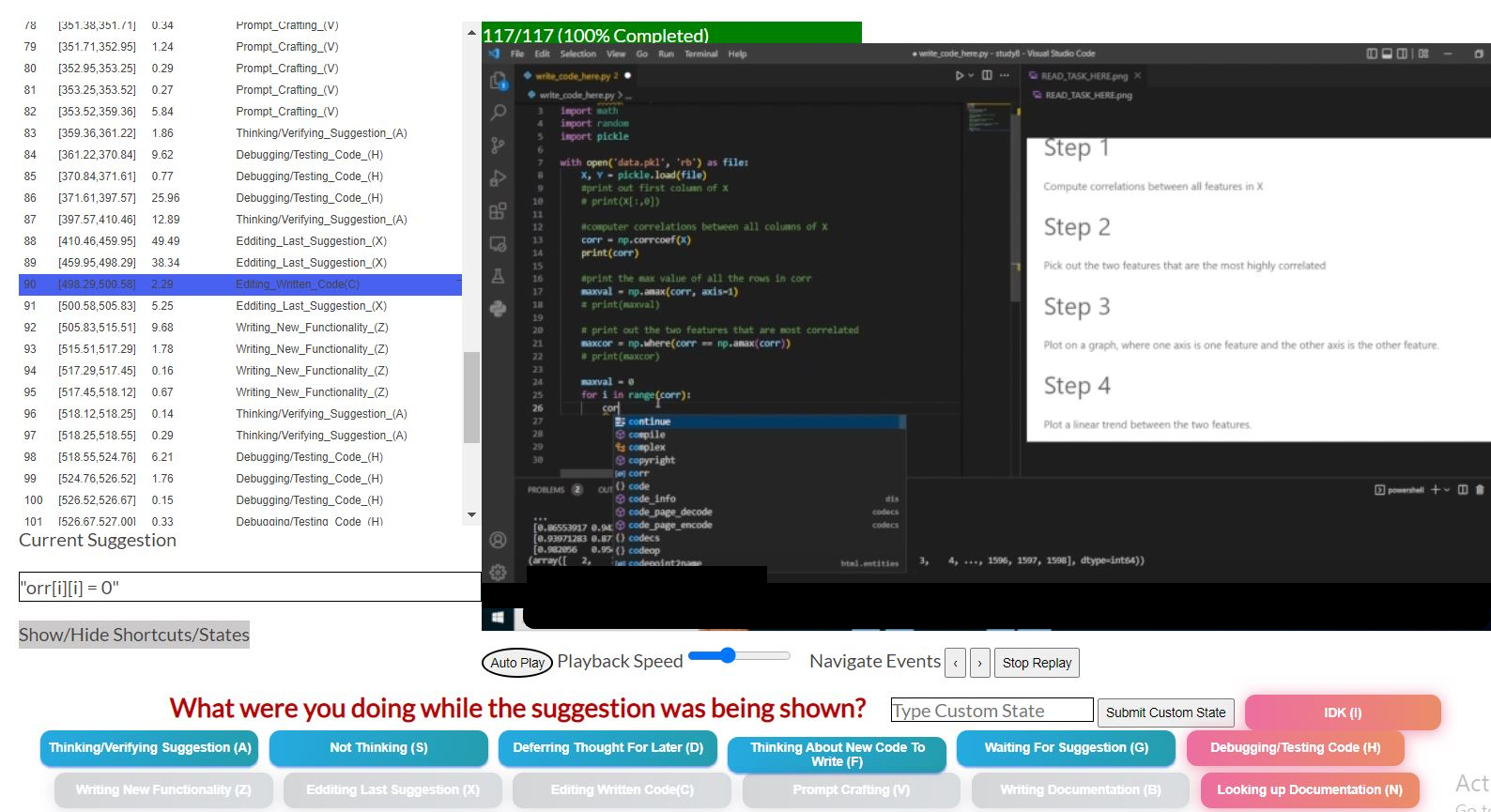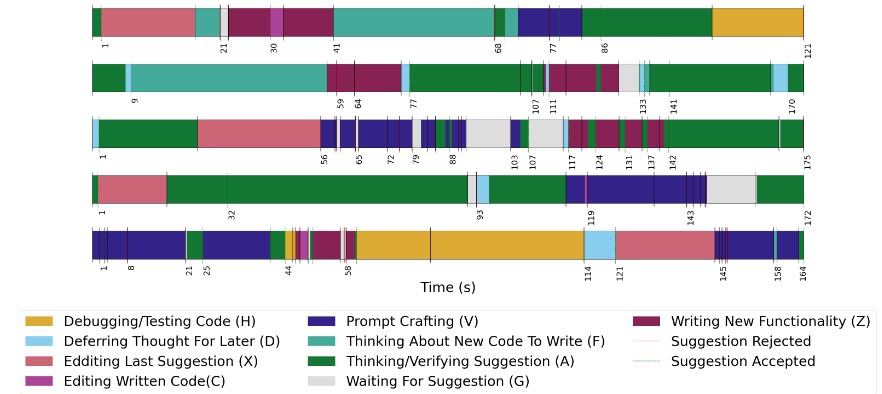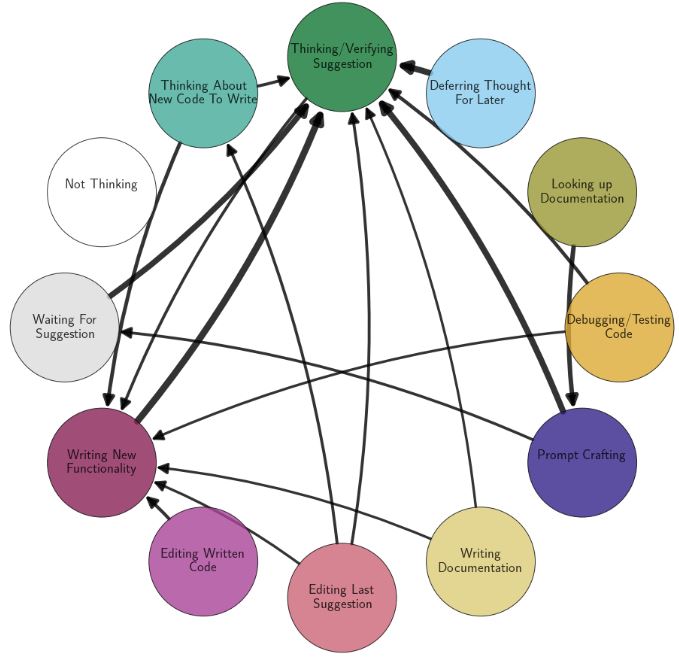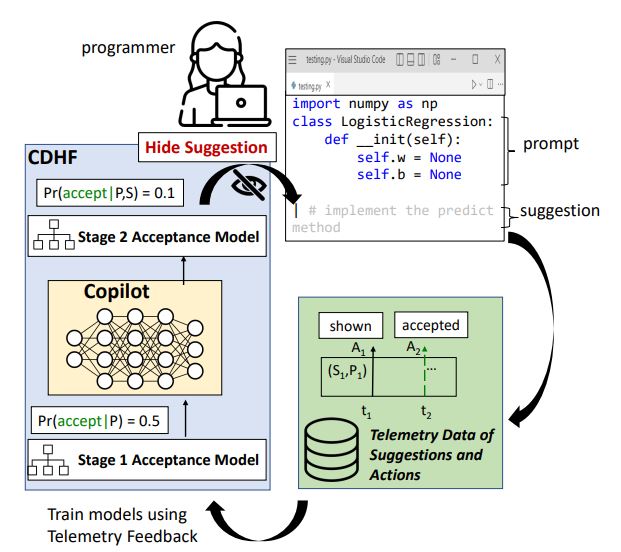Code and Data for:
-
Reading Between the Lines: Modeling User Behavior and Costs in AI-Assisted Programming Go To Code - CHI 2024
-
When to Show a Suggestion? Integrating Human Feedback in AI-Assisted Programming Go To Code - AAAI 2024
Dataframe of telemetry for the study is available in data pickle and processed in folder data
Video data of the coding session is available as a zipped folder at link (note logs for all sessions can be constructed from the pickle file, but we make 4 in a convenient json format available in the zip file)
-
Understanding how programmers use Copilot: our work enables an in depth study of how programmers use Copilot, and the different states programmers are in when using Copilot (CUPS). This repository contributes telemetry data of programmers completing tasks with Copilot and a detailed analysis of that data.
-
When should a suggestion be shown in Copilot? We contribute a simple method that predicts the probability of a programmer accepting a suggestion, and show that it can be used to improve the performance of Copilot by selectively showing suggestions.
The environment named 'coderec' is available as a yml file and can be installed using:
conda env create -f environment.yml
Some of the packages are not required for all the scrips and notebooks, but are included in the environment for convenience.
There is also a requirements.txt file available, but it does not include pip install so it is insufficient, to use that:
conda create --name coderec --file requirements.txt
We will also need to install further libraries and tools.
- Treesitter for getting code labels
git clone https://github.com/tree-sitter/tree-sitter-python
All code is found here
You can interact with the study data using our annotation interface.
Steps:
- First make sure to download the data including the labels (.json files) and the videos (.mp4 files).
- Place both the json and mp4 in the 'user_study_webapp/app_study/static' folder.
- For each study, run the following commands:
python server.py -p static/logs_user_8.json -v static/video_cropped_8.mp4
- Go to http://localhost:8080/ on your browser to see the interface.
We include the instructions for each coding task in coding_tasks
Use the jupyter notebook viz_draw to draw the timelines for the study data.
Use the jupyter notebook viz_draw to draw the graph for the study data.
For insights and analysis that are found in our paper, they can be replicated in the following notebooks:
- information and statistics about participants and sessions found in Section 5 of the paper
- results of the user study found in Section 6 of the paper
- predictive models of CUPS found in Section 7 of the paper
- recreate appendix graphs for post-study survey
Our study complete data is stored in '/data/data_labeled_study.pkl' which contains python array which we will name 'df_observations' where: 'df_observations[i]' is the session for the ith user stored as a pandas dataframe.
To be more explicit, df_observations[i] is a pandas dataframe that contains the following columns:
'UserId'
'TimeGenerated': timestamp for event
'StateName': betweeen 'Shown', 'Accepted', 'Rejected', 'Replay' (consecutive shown), 'Browsing' (shown different choice index)
'HiddenState' : high level hidden state between 'UserBeforeAction', 'UserPaused', 'UserTyping'
'TimeSpentInState'
'CurrentSuggestion'
'CurrentPrompt'
'Measurements': measurements from logs
'EditPercentage': an array containing the relative edit distance (in 0-1) for the 5 stillincode events for this completion
'LabeledState': the state label by the user for the current state
The LabeledState takes the following values:
Thinking About Suggestion (a): actively thinking/verifying about suggestion shown, also includes going to the internet to verify <br>
Not Thinking (s): not thinking about suggestion shown <br>
Deferring Thought For Later (d): decide to not think now about suggestion, but will think later about it <br>
Thinking About New Code To Write (f): thinking about code outside suggestions to write, new functionality <br>
Waiting For Suggestion (g): waiting for Copilot suggestion to be shown <br>
Writing New Code (z): writing code that implements new functionality <br>
Editing Recent Suggestions (x): editing recent Copilot suggestions<br>
Editing (Personally) Written Code(c): editing code you wrote that was not a Copilot suggestion for purpose of fixing functionality <br>
Prompt Crafting (v): writing comment or code with intention of copilot completion<br>
Writing Documentation (b): adding comments for purpose of documentation,<br>
Debugging/Testing Code (h): running or debugging code to check functionality, may include writing tests or debugging statements<br>
Looking at documentation: looking online for documentation
All code is found here
We have already performed this step for you for the user study logs and processed data is in data/featureframe_user_study.pkl
Given the extended logs, we will generate features for the prediction and decoding models.
The below command will generate a pickle file containing a python variable, name it 'df_features', of the following form:
df_features[i][j][h]: is the h'th feature for the k'th event for the ith user.
Let us elaborate further, df_features[i] is the all the data for the ith user. df_features[i][k] contains the features for the k'th event in the session. Finally, df_features[i][k][h] contains the h'th feature, more precisely, df_features[i][k] is a list of different feature, where df_features[i][k][h] is a list contains a representation of the h'th feature as follows:
feature_dict = {'Measurements: compCharLen, confidence, documentLength, numLines, numTokens, promptCharLen, promptEndPos, quantile': 0,
'edit percentage': 1, 'time_in_state': 2, 'session_features':3, 'suggestion_label':4, 'prompt_label':5,
'suggestion_embedding':6, 'prompt_embedding':7, 'suggestion_text_features':8, 'prompt_text_features':9, 'statename':10}
meaning df_features[i][k][0] is a list contaning all measurement features, i.e. compCharLen, confidence, documentLength, numLines, numTokens, promptCharLen, promptEndPos, quantile in a row. And then df_features[i][k][6] is the 768 dimensional suggestion embedding and so forth.
The command to get the features pickle file is:
python action_prediction/generate_features.py -p'OUTPUT_PATH_EXTENDED_LOGS.pkl' \
-c 0 \
-b 1000 \
-o 'OUTPUT_PATH_features.pkl' \
-e 1 \
-m 99999 \
the documentation for the args is:
('-p', '--path', help='Path to extended logs frame', required=True)
('-c', '--cudadevice', help='cuda device id', default=0, required=True, type=int)
('-b', '--batchsize', help='batch size', default=1000, required=True, type=int)
('-o', '--output', help='Output path of .pkl file', required=True)
('-e', '--embedding', help='Whether to get embeddings for suggestion and prompt', required=True, type=int)
('-m', '--maxusers', help='max users', default=100, required=True, type=int)
The figures and tables in the paper are generated using data from a larger dataset that is not provided for privacy reasons. However, one can perform all the analysis in the paper with the user study data that is collected in our 2022 paper.
-
Effect of Programmer Latent State analysis (page 6) can be replicated with the notebook effect_of_latent_state.ipynb
-
The results (page 10) of predicting accepts with XGB can be replicated with predict_accept_user_study.ipynb
-
Figure 7 (CDHF) can be replicated by first generating the models m1 and m2 and then running the notebook cdhf.ipynb
-
Figure 8 (which suggestion to show) and 10-11 can be replicated by first generating a model that only takes prompt and suggestion embeddings and running the notebook max_reward_accept.ipynb
Other figures (Figure 5, Figure 6) require the larger dataset and are not included in this release.
Please cite our papers if you use our dataset or code:
@article{mozannar2022reading,
title={Reading Between the Lines: Modeling User Behavior and Costs in AI-Assisted Programming},
author={Mozannar, Hussein and Bansal, Gagan and Fourney, Adam and Horvitz, Eric},
journal={arXiv preprint arXiv:2210.14306},
year={2022}
}
@article{mozannar2023show,
title={When to Show a Suggestion? Integrating Human Feedback in AI-Assisted Programming},
author={Mozannar, Hussein and Bansal, Gagan and Fourney, Adam and Horvitz, Eric},
journal={arXiv preprint arXiv:2306.04930},
year={2023}
}
This release is part of research done during an internship at Microsoft Research (privacy statement) and was based on valuable feedback from colleagues across MSR and GitHub including Saleema Amershi, Victor Dibia, Forough Poursabzi, Andrew Rice, Eirini Kalliamvakou, and Edward Aftandilian.
This project welcomes contributions and suggestions. Most contributions require you to agree to a Contributor License Agreement (CLA) declaring that you have the right to, and actually do, grant us the rights to use your contribution. For details, visit https://cla.opensource.microsoft.com.
When you submit a pull request, a CLA bot will automatically determine whether you need to provide a CLA and decorate the PR appropriately (e.g., status check, comment). Simply follow the instructions provided by the bot. You will only need to do this once across all repos using our CLA.
This project has adopted the Microsoft Open Source Code of Conduct. For more information see the Code of Conduct FAQ or contact opencode@microsoft.com with any additional questions or comments.
This project may contain trademarks or logos for projects, products, or services. Authorized use of Microsoft trademarks or logos is subject to and must follow Microsoft's Trademark & Brand Guidelines. Use of Microsoft trademarks or logos in modified versions of this project must not cause confusion or imply Microsoft sponsorship. Any use of third-party trademarks or logos are subject to those third-party's policies.



